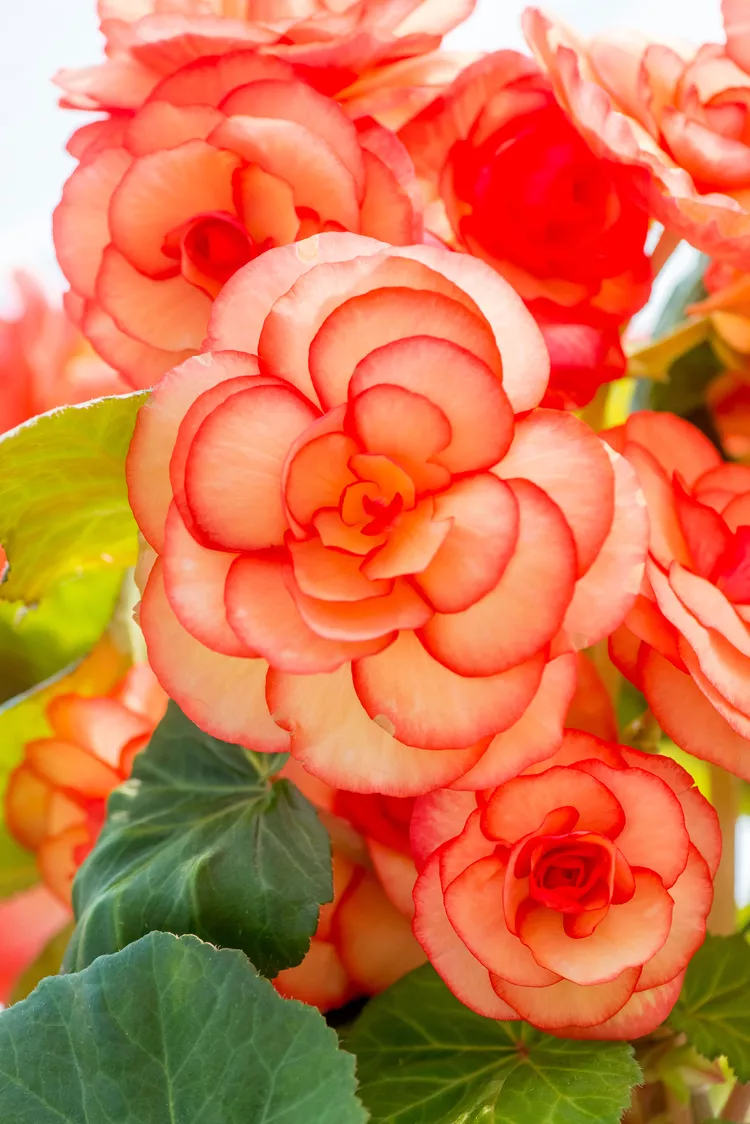Begonia flowers may not have as big a fan base as, say, roses or peonies, but they can be every bit as captivating. Begonias are a wildly diverse group of plants, not just the flowers you'll often see at gas stations. And recent breeding efforts have produced tons of new, exciting varieties to grow outdoors and as houseplants. Plus, unlike other popular flowering plants, begonia plants often sweeten the deal with attractive foliage. So, if you think begonia flowers are boring and old-fashioned, here are six facts that will change your mind.
1. A Rainbow of Begonia Flower Colors
Begonias are known for their wide range of leaf colors, but you'll also find begonia flowers in all sorts of hues. The more common colors of white, yellow, and pink have broadened dramatically in recent years to include a full range of hues, including red, orange, and peach. Through traditional breeding practices, many begonia varieties are now available with multicolored blooms that provide a show that rivals roses in their complexity and intensity.
:strip_icc():focal(658x1081:660x1083):format(webp)/big-rose-bronze-leaf-begonia-dd27e9dc-8add186610c241ff83e8028de7c8e263.jpg)
:strip_icc():focal(621x0:623x2):format(webp)/bellagio-apricot-begonia-40ed0842-cead48ad285a422898f0401186a358f6.jpg)
:strip_icc():focal(1334x0:1336x2):format(webp)/102314946_preview-879f81011e6a40b693ef892ce27bb470.jpg)
Robert Cardillo
2. Single and Double Form Begonia Flowers
Flowers across the world of plants come in a variety of forms, from simple and insignificant to complex and flamboyant. This variation exists across all the different begonia types, making for an exciting group to grow.
So, what are single and double flowers? Single flower forms are typically found in nature, and single begonia flowers commonly have as few as two petals but often four. They’re beautiful but not necessarily ostentatious. On the other hand, double-flowered begonias are found in cultivation and have lots of petals, to the point where they look almost like camellias or roses. These larger flowers require more energy from the plants but are very showy throughout their blooming period.
Interestingly, begonia varieties with double flowers do not all have the same number of petals; some flowers will appear much fuller and thicker than others. Just like with birds and some other creatures, the males are showier and have greater variability in form. And yes, begonia flowers are either male or female.
3. No Deadheading Required
Many plants require regular removal of old flowers (deadheading) to keep them reblooming throughout the season. Deadheading is needed with most flowering plants because they're attempting to make seeds. Cutting off old flowers causes plants to grow new flowers in their constant quest to reproduce.
With some plants, however, this isn't necessary. Begonias fall into this category and rarely—if ever—need to be deadheaded to stimulate new blooms. If their flowers aren't pollinated, they drop off relatively quickly and are replaced by new flowers. Newer varieties of wax begonias (Begonia semperflorens) and dragon wings, as well as their derivatives, will typically bloom throughout the summer until frost.
4. Sweet Scents
Although most begonia flowers aren't scented, some do have a fragrance. Species such as Begonia odorata and some newer hybrids produce a light fragrance noticeable on the breeze. Look for cultivars such as 'Angelique', a double-flowered B. odorata hybrid with white to pink blooms. Begonia odorata is also known for its sun tolerance, meaning many varieties derived from the species can handle growing in full sun.
5. Hummingbird Magnets
Begonias are a hugely diverse group of plants, and that diversity extends to the types of pollinators attracted to their flowers. Many species of begonias and their varieties are excellent sources of nectar that hummingbirds find irresistible. Hummingbirds often seek out orange and red-colored flowers, and some species, like Begonia boliviensis, fit the bill perfectly as they are native to hummingbird country in the Andes of South America.
6. Edible Begonia Flowers
While you might never have thought about biting into your begonias, the flowers are indeed edible. For the edible flower connoisseurs out there, some of the tastiest begonias available are also loaded with petals. Common types, such as tuberous and wax begonias, are said to have a cucumber-like crunch and a slightly citrusy, tangy taste.
Begonia Flowers to Grow
There are many varieties of begonias, so look at the different types and decide which would be best for you. Double-blossomed tuberous begonias are great for shady spots or in pots. Rex begonias are prized for their showy leaves and can be grown in the sun. However, they're toxic to pets and should be planted where they won't be nibbled on. Pair begonia flowers with herbs for a container garden. If you're interested in raising begonias as houseplants, follow these tips for their care.




















